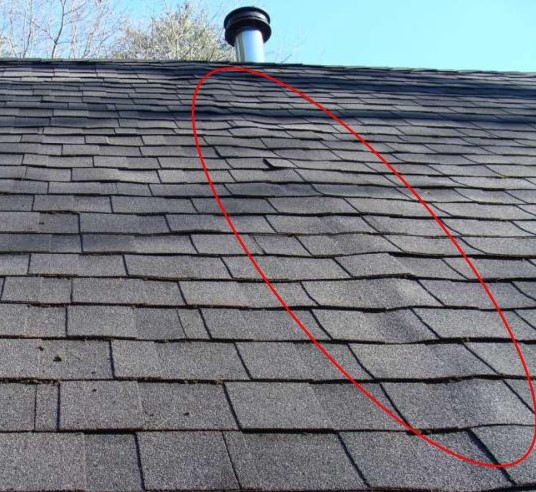The good news is that most shingle ridging cases I’ve encountered have been largely an aesthetic issue and not a failure in structure or performance. The term shingle ridging is not unique to the SIP industry. In fact, if you happen to look up at a large number of conventionally framed roofs, you will see occasional examples of the tell-tale shadow lines resulting from the asphalt or fiberglass shingles buckling upward. The buckling is caused by movement of the substrate that the composite shingle is nailed in to. This movement can be caused by heat or moisture or both. The issue occurs exclusively at the joints of the substrate. Or in our case at the joints of the SIP. To better understand this buckling, place a piece of paper flat on the desk in front of you. Imagine there is a SIP joint that runs under your piece of paper between your belly-button and the computer monitor directly in front of you. Place your hands flat on the paper on either side of our imaginary joint and think of your hands as the nails that attach the shingle to the SIP. Now imagine heat and/or moisture causing movement with the result being that the SIP joint becomes narrower. The joint was ¼” when the shingles were installed but the SIP joint has shrunk to zero gap between the SIP skins. To mimic this joint shrinking to zero, move your hands together ¼” while pinching the paper between your hands and the desk. The result is that the paper (or the shingle) will buckle upwards to create a ridge.
So why did the SIP move?
There could be a number of reasons why movement occurs. Many of these reasons have nothing to do with the installation being anything less than proper and as intended by the SIP manufacturer. One cause of the movement is based on expansion of the SIP skin. All skins (OSB, cement, metal, MgO, etc.) have physical properties that result in expansion with either heat, increased moisture or both. If a SIP skin expands, the joint around the SIP tends to get smaller. This movement results in the ridging that you experienced with your paper experiment above. In the case of OSB skinned SIPs, and especially jumbo SIPs, the acclimation of the wood skin causes it to grow slightly over time. This acclimation process is inevitable and can be the cause of shingle ridging. A recently pressed sheet of 7/16 OSB leaving the manufacturing mill has a moisture content in single digits. Depending on how quickly inventory is used and shipped to the site (from the SIP manufacturer), some OSB will still have a relatively low percentage of moisture. Depending on where you build, the final acclimation of your SIP skin could be as high as 20% or more. This increase in moisture will cause expansion. Hence, if your roofer is on schedule (I know that’s a long-shot), you could be applying perfectly good shingles to perfectly installed SIPs and the physics of moisture-induced expansion will inevitably cause your SIP joint to narrow and your shingle to buckle.
What can I do if it’s already happened?
If the ridging has already occurred, you could just wait. I’ve had ridging appear on roofs within the first few months of the shingle being attached and disappear a year later. The nature of ridging is that it is more visible when the sun is low in the sky and the shadow is more pronounced. A ridged shingle will, in most cases, relax and settle back down with the result being “no-harm, no-foul”.
What can I do to prevent it in pre-construction?
I recommend a number of paths to prevent having to deal with the unsightly bulge. I stress the importance of a good quality shingle. Especially one that is an architectural shingle that has more texture. If ridging occurs, it sticks out like a sore thumb on a cheaper 3-tab shingle roof. The heavier architectural shingle will camouflage the issue much better. In addition, you could further qualify your build with a back-ventilated roof which separates the shingle from the SIP and allows movement that never transfers into the ridging.
But, you ask, can ridging be a result of poor sealing and leaking air from within? YES it can. Let’s talk about that in Shingle Ridging Part 2, coming soon!
